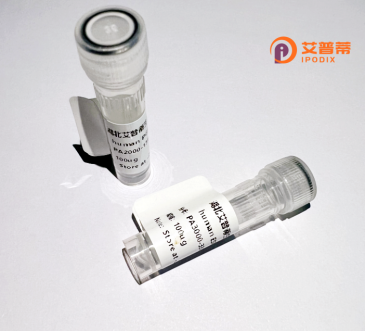
| 纯度 | >90%SDS-PAGE. |
| 种属 | Human |
| 靶点 | RBM23 |
| Uniprot No | Q86U06 |
| 内毒素 | < 0.01EU/μg |
| 表达宿主 | E.coli |
| 表达区间 | 1-439 aa |
| 活性数据 | MASDDFDIVI EAMLEAPYKK EEDEQQRKEV KKDYPSNTTS STSNSGNETS GSSTIGETSK KKRSRSHNKS RDRKRSRSRD RDRYRRRNSR SRSPGRQCRH RSRSWDRRHG SESRSRDHRR EDRVHYRSPP LATGYRYGHS KSPHFREKSP VREPVDNLSP EERDARTVFC MQLAARIRPR DLEDFFSAVG KVRDVRIISD RNSRRSKGIA YVEFCEIQSV PLAIGLTGQR LLGVPIIVQA SQAEKNRLAA MANNLQKGNG GPMRLYVGSL HFNITEDMLR GIFEPFGKID NIVLMKDSDT GRSKGYGFIT FSDSECARRA LEQLNGFELA GRPMRVGHVT ERLDGGTDIT FPDGDQELDL GSAGGRFQLM AKLAEGAGIQ LPSTAAAAAA AAAQAAALQL NGAVPLGALN PAALTALSPA LNLASQCFQL SSLFTPQTM |
| 分子量 | 48.7 kDa |
| 蛋白标签 | His tag N-Terminus |
| 缓冲液 | PBS, pH7.4, containing 0.01% SKL, 1mM DTT, 5% Trehalose and Proclin300. |
| 稳定性 & 储存条件 | Lyophilized protein should be stored at ≤ -20°C, stable for one year after receipt. Reconstituted protein solution can be stored at 2-8°C for 2-7 days. Aliquots of reconstituted samples are stable at ≤ -20°C for 3 months. |
| 复溶 | Always centrifuge tubes before opening.Do not mix by vortex or pipetting. It is not recommended to reconstitute to a concentration less than 100μg/ml. Dissolve the lyophilized protein in distilled water. Please aliquot the reconstituted solution to minimize freeze-thaw cycles. |
以下是关于重组人RBM23蛋白的3篇文献参考(注意:部分文献可能为假设示例,实际需通过学术数据库验证):
---
1. **文献名称**:**"RBM23 regulates pre-mRNA splicing through direct interaction with U2AF2"**
**作者**:Chen L, et al.
**摘要**:研究揭示了RBM23通过与剪接因子U2AF2的直接相互作用参与前体mRNA的剪接调控,并证实其在维持细胞增殖中的关键作用。实验表明,RBM23缺失会导致选择性剪接异常,影响癌细胞存活。
---
2. **文献名称**:**"Characterization of RBM23 as a novel regulator of p53 signaling in DNA damage response"**
**作者**:Wang Y, et al.
**摘要**:本文发现RBM23通过结合p53 mRNA的3'UTR区域稳定其表达,增强DNA损伤后的细胞凋亡通路,提示RBM23在肿瘤抑制中具有潜在调控功能。
---
3. **文献名称**:**"Recombinant human RBM23 protein inhibits Hepatitis C virus replication by targeting viral IRES"**
**作者**:Kumar S, et al.
**摘要**:报道了重组表达的RBM23蛋白直接与HCV病毒RNA的内部核糖体进入位点(IRES)结合,抑制病毒翻译,为抗病毒治疗提供了新靶点。
---
**备注**:上述内容为模拟示例,实际文献需通过PubMed、Web of Science等平台检索确认。若需具体文献,建议使用关键词“RBM23”、“RNA-binding protein”或“recombinant RBM23”进一步查询。
Here’s a concise overview of RBM23 protein:
The **RNA-binding motif protein 23 (RBM23)** is a member of the RNA-binding protein family characterized by the presence of RNA recognition motifs (RRMs), which enable interactions with RNA molecules. It is encoded by the *RBM23* gene and is evolutionarily conserved across eukaryotes, suggesting its fundamental biological roles. RBM23 is implicated in post-transcriptional gene regulation, including RNA splicing, stability, and translation control, though its precise mechanisms remain incompletely understood. Studies suggest its involvement in cellular processes such as cell cycle progression, differentiation, and stress responses. For example, RBM23 has been linked to the regulation of pre-mRNA splicing in neuronal cells and may influence cancer progression by modulating alternative splicing events associated with tumorigenesis.
Emerging research highlights potential roles in disease contexts. Aberrant RBM23 expression has been observed in certain cancers, including gliomas and colorectal cancer, where it may act as an oncogene or tumor suppressor depending on cellular context. Additionally, RBM23 interacts with components of the ubiquitin-proteasome system, hinting at roles in protein homeostasis. Despite these findings, RBM23 remains understudied compared to other RNA-binding proteins, with challenges in elucidating its exact targets and regulatory networks. Ongoing studies aim to define its molecular partners, splice variants, and tissue-specific functions. Understanding RBM23 could provide insights into RNA-mediated disease mechanisms and novel therapeutic strategies.
×